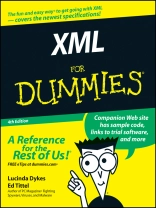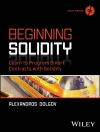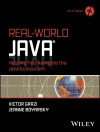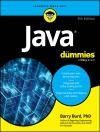See how XML works for business needs and RSS feeds
Create consistency on the Web, or tag your data for different
purposes
Tag — XML is it! XML tags let you share your format as well as
your data, and this handy guide will show you how. You’ll soon be
using this markup language to create everything from Web sites to
business forms, discovering schemas and DOCTYPES, wandering the
Xpath, teaming up XML with Office 2003, and more.
Discover how to
* Make information portable
* Use XML with Word 2003
* Store different types of data
* Convert HTML documents to XHTML
* Add CSS to XML
* Understand and use DTDs
विषयसूची
Introduction 1
Part I: XML Basics 9
Chapter 1: Getting to Know XML 11
Chapter 2: Using XML for Many Purposes 23
Chapter 3: Slicing and Dicing Data Categories: The Art of Taxonomy 33
Part II: XML and the Web 45
Chapter 4: Adding XHTML for the Web 47
Chapter 5: Putting Together an XML File 65
Chapter 6: Adding Character(s) to XML 83
Chapter 7: Handling Formatting with CSS 95
Part III: Building In Validation with DTDs and Schemas 109
Chapter 8: Understanding and Using DTDs 111
Chapter 9: Understanding and Using XML Schema 135
Chapter 10: Building a Custom XML Schema 157
Chapter 11: Modifying an Existing Schema 173
Part IV: Transforming and Processing XML 195
Chapter 12: Handling Transformations with XSL 197
Chapter 13: The XML Path Language 215
Chapter 14: Processing XML 235
Part V: XML Application Development 245
Chapter 15: Using XML with Web Services 247
Chapter 16: XML and Forms 259
Chapter 17: Serving Up the Data: XML and Databases 271
Chapter 18: XML and RSS 285
Part VI: The Part of Tens 299
Chapter 19: XML Tools and Technologies 301
Chapter 20: Ten Top XML Applications 313
Chapter 21: Ten Ultimate XML Resources 321
Glossary 329
Index 347
लेखक के बारे में
Lucinda Dykes started her career in a high-tech area of
medicine, but left medicine to pursue her interests in technology
and the Web. She has been writing code and developing Web sites
since 1994, and also teaches and develops online courses —
including the Java Script courses for the International Webmasters
Association/HTML Writers’ Guild at www.eclasses.org.
Lucinda has authored, co-authored, edited, and been a contributing
author to numerous computer books; the most recent include
Dreamweaver MX 2004 Savvy (Sybex), XML for Dummies
(3rd Edition, Wiley), Dreamweaver MX Fireworks MX Savvy
(Sybex), XML Schemas (Sybex), and Mastering XHTML
(Sybex). When she can manage to move herself away from her
keyboard, other interests include holographic technologies, science
fiction, and Bollywood movies.
Ed Tittel is a 23-year veteran of the computing industry.
After spending his first seven years in harness writing code, Ed
switched to the softer side of the business as a trainer and
talking head. A freelance writer since 1986, Ed has written
hundreds of magazine and Web articles — and worked on over
100 computer books, including numerous For Dummies titles on
topics that include several Windows versions, Net Ware, HTML, XHTML,
and XML.
Ed is also Technology Editor for Certification Magazine,
writes for numerous Tech Target Web sites, and writes a
twice-monthly newsletter, ‘Must Know News, ‘ for
Cram Session.com. In his spare time, Ed likes to shoot pool, cook,
and spend time with his wife Dina and his son Gregory. He also
likes to explore the world away from the keyboard with his trusty
Labrador retriever, Blackie. Ed can be contacted at
[email protected].












